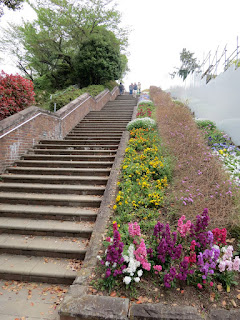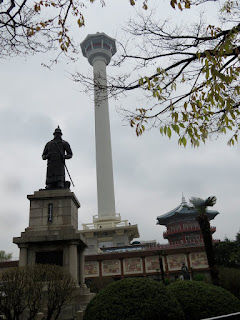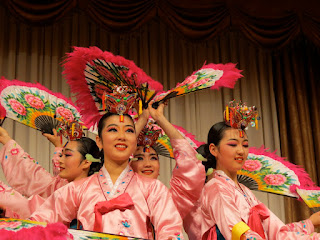Thu Apr 19 Nagasaki, Japan 8:00am 6:00pm
Every morning I was awakened by a 6 am wake-up call so I would not miss anything. When the Zaandam pulled into Nagasaki harbor I was out on deck.
An early bird crew member out on the deck consented to having her picture taken. Orange is the color of the House
of Orange in Holland.
The cruise ship dock at Matsugae Pier was in a very convenient location, adjacent to the city center. Cruise ship passengers could easily walk from here to the entrance to Glover Garden in 10 minutes. This I did.
First of all I had to buy some yen because the streetcar does not accept US dollars. 5,000 yen cost me around $66. A tram ticket required 120 yen.
Fortified with local currency I left the pier.
I wasn't really tipsy, I just did not rotate the photo
of me before pasting it here.
The walk was uphill and I paused only to take a photo of the wooden, Gothic-style Oura Catholic Church, built in 1863 for the foreign community. The church was designed by a French missionary and built by Japanese carpenters; it was the church of massacred 26 Christians. The Christians were publicly crucified on Nishizaka Hill February 5, 1597, as a warning. A decade later, Christianity was banned outright.
Glover Garden is set in a hillside park, that dates back to the 19th century when Western merchants established settlements in Nagasaki to promote trade between the East and West. Glover Garden is located on a slope directly above and to the right of the Oura Catholic Church mentioned. There were more stairs than I had anticipated; fortunately the park had series of escalators to help out.
The garden's name comes from Thomas Glover, a Scot, who -- during the Meiji Restoration in the late 19th and early 20th centuries -- established Japan's first railroad and the shipbuilding industry that later became Mitsubishi. I was especially impressed with the man-made waterfall cascading down a stoney wall.
As I was exploring, some school girls walked by and consented to having their picture taken, They looked like little sailors in their school uniforms They were friendly and very willing to be photographed..
Now for the A Bomb sites. The city's tram lines were easy to navigate. I paid the flat fare of 120 yen when getting off. The tram lines were numbered 1, 3, 4 and 5, and the stops were both numbered and written in English letters. The stop for tram 5 was just outside the wharf precinct and to the left. Tram lines 1 and 3 stopped close to the Nagasaki Bomb Museum, a 15-minute ride from the city center. I choose stop 3 which was closest to the Peace Park.
I had to walk up a large number of steps to reach the park proper. Beautiful flowers were planted along the stairway.
At the top of the steps was the Peace Fountain. This fountain was dedicated to those who died in a desperate search for water following the atomic attack on August 9, 1945.
School children visiting the site had somber faces as their guide explained its significance. Nagasaki's strategically important shipbuilding industry made the city a target in World War II. On August 9, 1945, the Americans dropped a plutonium A-bomb on the city, three days after the one at Hiroshima. The bomb was supposed to land in the heart of the city, with its industry and shipyards, but poor visibility resulted in the bomb landing in the northern suburbs instead. Of a population estimated to be 240,000, 73,844 were killed, and just as many were injured by the blast, heat rays and radiation.
Also at the Peace Park, was a sculpture of a man with his right hand pointing to the sky from whence the bomb came and left hand outstretched, asking for help.
There were many other memorial markers that
stressed hope for the future.
This one depicted a woman protecting the future.
Bell Tower Monument
A marker explained that here was the site of a prison that had been obliterated by the explosion.
The site as it appeared after the bombing.
The foundation of the prison remains.
Nearby Ground Zero Park entrance:
Concentric circles around a black monolith point out the epicenter, where the bomb actually exploded.
I boarded streetcar #1 for my trip back to the cruise dock.
When back on board I looked out the window and saw a Japanese farewell group performing on the dock for us visitors.
It started to rain but the cheerleaders were not deterred. Since I was taking pictures through a window, the photos were not as clear as I would like them to be.
And the band played on.
Settled back at my dinning table, I tackled my Halibut filet (with spinach and Rice) dinner,
Fri Apr 20 Busan, South Korea 8:00 am 5:00 pm
I was up on deck when we reached the breakwater for the port of Busan. Busan (formerly spelled Pusan) is the fifth busiest seaport in the world, with transportation and shipping highlighting the local economy.
As in other ports, we were greeted by a harbor tug that ushered us to the docking area.
As Busan was one of the few areas in Korea that remained under the control of South Korea throughout the Korean War, for some time it served as a temporary capital of the Republic of Korea. UN troops established a defensive perimeter around the city known as the Pusan Perimeter in the summer and autumn of 1950.
I explored a portion of the city on my own, concentrating on Yong Dusan Park.
A complimentary city bus offered transportation. I saw much of the city through the bus window. Although it was raining lightly and the windows were streaked, I could not resist taking photos of flower pots along the city streets.
Our blue bus dropped us off at Yong Dusan Park. The light rain was hardly a factor during my wandering.
Busan Tower
Blossoming tree:
Bell Pavilion:
Floral Clock:
Dragon Monument: "Yongdusan" means a mountain shaped like the head of a dragon, but the mountain is difficult to discern because of surrounding building
Statue of Admiral Yi Sun Shin:
A shopping center was situated in the park so I picked up a T-shirt for my wife. At the doorway vistors were greeted with a friendly welcome.
The park was also a touring spot for school children.
Holland America offered a tour for a Busan Show. We transfered by motor coach to one of the performance halls.
Traditional music and dance performance: The program began with Samulnori with percussion instruments of drums and gongs used in farmer dances.
Hachum (Crane Dance) followed by Seoljanggu.
Buchaechum, colorful fan dances:

Pangut, featuring many characters such as monks and hunters:
On the way back to our ship we passed cluster after cluster of high rise apartments. We were supposed to visit Haeundae Beach—almost a mile long—a lovely stretch of white sand with recreational facilities such as resorts, casinos and spas. For some reason this portion was dropped with no explanation.
The appetizer I selected for dinner that night was thinly sliced tenderloin fashioned in a circle.
For dessert I selected Chocolate Brownie with a scoop of ice cream. Because I ordered this so often, Emil thought I should ask for a box to take some home.
After dinner I ambled over to Show Time to enjoy a performance by Dennis Blair, an accomplished screenwriter, award-winning songwriter and comedic actor.
Then came night time with my towel animal. I always felt
being watched.
GO ON TO PACIFIC CRUISE PART III






































































No comments:
Post a Comment